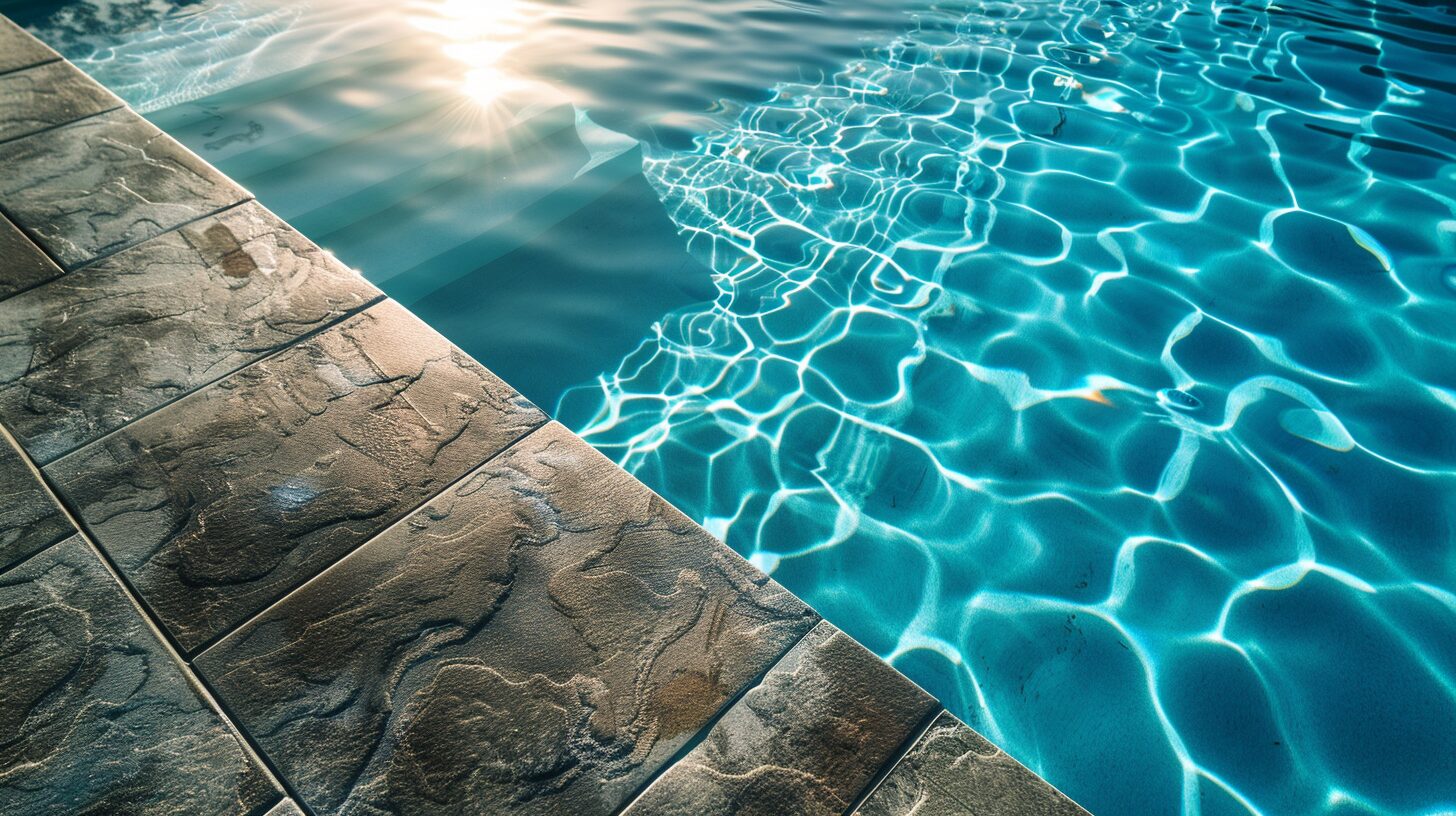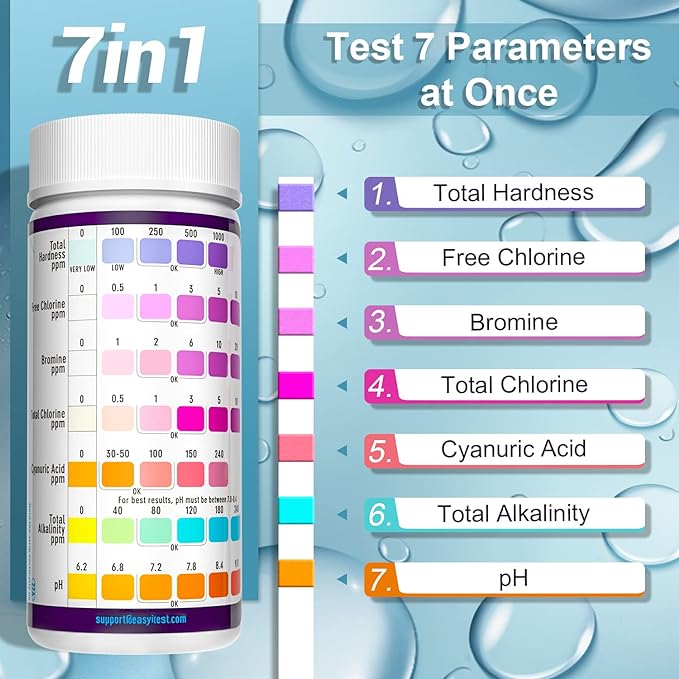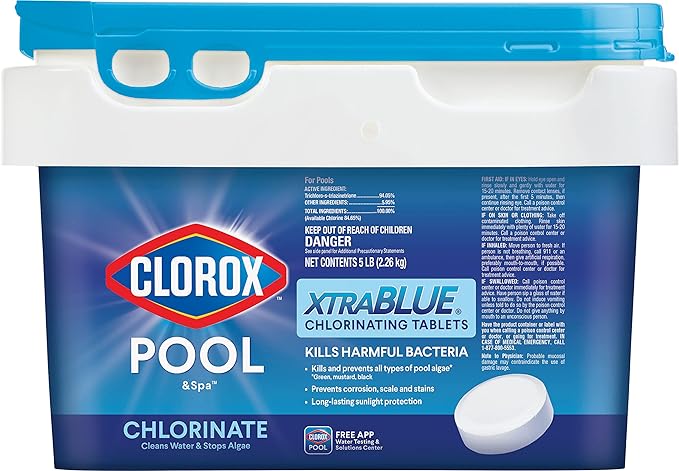Welcome to the ultimate guide on how to balance pool water — a cornerstone task for any pool owner seeking clarity, safety, and longevity for their aquatic oasis. In this comprehensive journey, we delve into the essence of pristine pool maintenance, emphasizing the critical roles of pH Level Management, Chlorination, and Algaecide Application. Whether you’re a first-time pool owner or a seasoned pro looking to refine your water care technique, our insights will elevate your maintenance routine to new heights.
With a spotlight on scientific principles and practical advice, we’ll guide you through each step necessary to achieve that perfect equilibrium in your pool water, ensuring a safe and inviting swim every time. From understanding the chemistry behind balanced pool water to mastering the application of essential treatments, this article is your all-in-one resource for maintaining a crystal-clear pool all season long. Join us as we explore the secrets to a balanced and beautiful pool, making your backyard the envy of the neighborhood.
| Feature | Description | Importance |
| Balance Pool Water | Achieving the ideal chemical balance in pool water, including pH, chlorine levels, and alkalinity. | Essential for ensuring water is safe, clear, and comfortable for swimmers. Prevents corrosion and scaling. |
| pH Level Management | Keeping the pH level within the ideal range of 7.2 to 7.8. | Critical for swimmer comfort, effectiveness of chlorine, and protection of pool equipment. |
| Chlorination | Adding chlorine to pool water to kill bacteria, viruses, and algae. | Key for sanitizing the pool and ensuring the water is safe for swimming. Affects water clarity and swimmer health. |
| Algaecide Application | Using algaecides to prevent or kill algae growth. | Prevents algae blooms that can make pools slippery, clog filters, and create unsanitary conditions. |
| Scientific Principles | Understanding the chemistry behind pool water balance. | Helps pool owners make informed decisions about water treatment and maintenance. Provides a foundation for troubleshooting and fine-tuning water quality issues. |
Unlocking the Secrets of Balance Pool Water: A Beginner’s Guide
Diving into the world of pool maintenance, the first and perhaps most crucial step is to unlock the secrets of balance pool water. This journey begins with an understanding that achieving the perfect balance is not just about adding chemicals to the water; it’s about embracing a scientific approach that ensures safety, comfort, and clarity for every swimmer. At the heart of this process are three pillars: pH Level Management, Chlorination, and Algaecide Application, each playing a vital role in the symphony of pool water perfection.
pH Level Management is the foundation upon which balanced pool water rests. A pH level within the ideal range of 7.2 to 7.8 is not merely a number; it’s a critical equilibrium point where water is neither too acidic nor too alkaline. This balance affects everything from the effectiveness of chlorine in killing bacteria and viruses to the protection of pool equipment and the comfort of swimmers’ skin and eyes. It’s a delicate dance of chemistry, where even a slight deviation can disrupt the harmony of your pool’s ecosystem.
Chlorination then enters as the powerful sanitizer, keeping the water free from harmful microorganisms. It’s not just about dumping chlorine into the water; it’s about maintaining the right levels that ensure safety without compromising comfort. Too little chlorine, and you risk algae blooms and bacterial contamination; too much, and swimmers might experience eye and skin irritation. This balance is essential for a crystal-clear pool that invites you in with open arms.
Lastly, Algaecide Application stands as the guardian against unwanted green guests. Algae not only detract from your pool’s beauty but can also create slippery surfaces and clog filters. Incorporating algaecides as part of your maintenance routine ensures that algae blooms are kept at bay, preserving the aesthetic and functional integrity of your pool.
Understanding these principles is like holding a master key to balance pool water—it empowers you to create a safe, inviting, and pristine aquatic environment. This holistic approach, rooted in scientific understanding and careful application, transforms pool maintenance from a chore into a craft, where each action you take brings you closer to the perfect balance.
The Critical Role of pH Level Management in Your Pool
Navigating through the intricacies of pH Level Management in pool care unveils a realm where science and diligence converge to safeguard the essence of your swimming haven. This critical component of balance pool water strategy stands as a testament to the fine line between the serene blue of perfection and the murky depths of negligence. It’s a domain where understanding the nuanced interplay between water chemistry and pool health becomes paramount, providing a clear beacon for those aiming to ensure an optimal aquatic environment.
The journey into pH management is guided by the golden rule: maintain your pool’s pH within the ideal range of 7.2 to 7.8. Straying too far on either side of this spectrum can lead to a cascade of challenges. On one end, low pH levels can corrode pool components, irritate swimmers’ skin and eyes, and diminish the effectiveness of chlorine—your pool’s sanitary shield. On the other, high pH levels foster an environment where chlorine’s disinfecting power is weakened, leaving the door open for bacteria and algae to thrive, clouding your pool’s clarity and inviting unwelcome odors.
Chlorination and Algaecide Application intertwine with pH level management, as their efficacy is heavily influenced by the water’s acidity or alkalinity. Achieving that delicate balance ensures chlorine can perform its vital role of sanitization efficiently, without the need for excessive doses that could harm swimmers or the pool’s structural integrity. Similarly, algaecides reach their peak potential in water that’s perfectly poised in its pH balance, ensuring algae spores find no refuge in your aquatic sanctuary.
In essence, mastering pH Level Management is akin to mastering the art of pool care itself. It demands a vigilant eye and a steady hand to navigate the chemical nuances, ensuring your pool remains a bastion of health, safety, and crystal-clear beauty. It’s a skill that not only preserves the physical integrity of your pool but also enhances the overall swimming experience, making every dip a dive into pure, balanced bliss.
Chlorination: The Key to a Crystal-Clear Pool
In the realm of pool maintenance, Chlorination emerges as a pivotal force, a guardian of purity in the crystalline waters that grace our backyards. This method, central to the balance pool water strategy, wields the power of chlorine to wage a silent yet relentless war against the microscopic invaders that threaten to usurp the sanctity of our aquatic havens. Chlorine’s role transcends mere sanitation; it is the linchpin that holds the delicate equilibrium of pool health, ensuring every splash and dive is met with the embrace of safe, clean water.
The science of chlorination is a dance of precision and timing, where understanding the nuances of pH Level Management plays a starring role. Chlorine’s disinfecting prowess peaks within a specific pH window, highlighting the symbiotic relationship between these two facets of pool care. Striking the right balance ensures that harmful bacteria and viruses are efficiently eradicated, without subjecting swimmers to the harshness of over-chlorinated waters.
Yet, the narrative of chlorination extends beyond the eradication of unseen foes. It is intrinsically linked to the prevention of algae blooms, a task where Algaecide Application also takes center stage. Together, they form a dynamic duo, each enhancing the other’s effectiveness. Algaecides rely on the sanitized environment that chlorine provides, while chlorination is made more efficient in water free from the burdensome load of algae.
Delving deeper, the application of chlorine is an art that demands both knowledge and experience. It involves not just the act of adding chlorine to water, but understanding its various forms and how they interact with the pool’s ecosystem. From tablets to liquid, each form has its place and purpose, tailored to different needs and pool types.
Chlorination stands not just as a method, but as a testament to the intricate ballet of chemistry and care that defines the essence of pool maintenance. It encapsulates a commitment to health, safety, and clarity, ensuring that the waters that glisten under the sun remain a source of joy and refreshment. Balancing this element with the precise art of pH management and algaecide application elevates the pool experience, transforming it from a mere activity to a dive into the epitome of aquatic bliss.
Algaecide Application: Your Ultimate Algae Defense Strategy
The battle against the verdant invaders of our pools—algae—requires a specialized arsenal, with Algaecide Application standing at the forefront. This strategic measure is more than just a treatment; it’s a preemptive strike and a curative solution rolled into one, crucial for maintaining the balance pool water. In the aquatic theatre of war against these relentless foes, algaecides serve as the cavalry, charging in to restore order and clarity to waters threatened by the murky grasp of algae blooms.
Algaecides, when wielded with expertise, work in concert with Chlorination and pH Level Management to create a trifecta of pool health. The effectiveness of algaecides is significantly influenced by the water’s chemical balance. A pool with perfectly balanced pH levels and adequately maintained chlorine is an environment where algaecides can perform at their peak, targeting algae without harming the pool’s ecosystem or its human enjoyers. This delicate balance ensures that the water remains inviting, clear, and safe for every swimmer, turning what could be a breeding ground for algae into a bastion of cleanliness.
Deploying algaecides is not merely about eradicating existing algae; it’s about preventing future invasions. Regular application according to manufacturer guidelines acts as a shield, deterring algae from reclaiming their lost territories. This preventative approach, combined with vigilant pH Level Management and diligent Chlorination, forms a comprehensive defense strategy that protects pools from the aesthetic and structural damages caused by unchecked algae growth.
Understanding the nuances of Algaecide Application—from choosing the right type for your pool to knowing the optimal timing for treatment—transforms pool maintenance from a routine task into an art. It’s about foreseeing potential issues before they arise and addressing them with precision, ensuring that the water remains a crystal-clear canvas of aquatic pleasure. In this context, algaecides are not just chemicals; they are the guardians of pool integrity, working silently yet effectively to preserve the beauty and health of our aquatic retreats. This holistic approach to pool care, where algaecides play a vital role alongside chlorination and pH management, epitomizes the pursuit of perfect balance, ensuring that every pool is a sanctuary of pure, unblemished water.
Maintaining the Perfect Balance: Tips and Tricks for Pool Owners
Maintaining the Perfect Balance: Tips and Tricks for Pool Owners encapsulates the essence of what it means to own and cherish a swimming pool. Achieving and sustaining the balance pool water is not merely a task; it’s a commitment to the health, safety, and enjoyment of every individual who dips into its embrace. This balance is a delicate harmony of chemical precision, where pH Level Management, Chlorination, and Algaecide Application play leading roles in the symphony of pool care.
Embarking on this journey, the first step for every pool owner is to embrace the ritual of regular testing. Monitoring the water’s pH, chlorine levels, and alkalinity becomes a gateway to understanding the pool’s current state and preempting any issues before they escalate. With pH Level Management, the goal is to keep the water’s acidity or alkalinity in check, ensuring that the environment is neither corrosive to pool equipment nor irritating to swimmers.
Chlorination follows as a critical pillar, a process where knowing the right amount of chlorine to add becomes an art form. It’s about striking the perfect balance between eliminating harmful pathogens and maintaining water that is gentle on the skin and eyes. Then comes Algaecide Application, a preventive measure that, when used wisely, keeps algae at bay, ensuring the pool remains a clear, inviting oasis free from unsightly green invaders.
But beyond these chemical balances, maintaining the perfect balance also involves physical care—skimming, vacuuming, and brushing the pool regularly to remove debris and prevent algae from adhering to surfaces.
Ultimately, the art of balancing pool water lies in the integration of scientific principles with proactive maintenance practices. It’s a dynamic process that adapts to changing conditions, requiring attention, knowledge, and sometimes, a touch of intuition. By following these tips and tricks, pool owners can ensure their pools remain not just bodies of water, but sanctuaries of joy, health, and crystal-clear beauty, inviting to all who seek respite within their cool embrace.
Maintaining your pool water is crucial for ensuring a safe and enjoyable swimming experience. Here’s a step-by-step guide to help you keep your pool water perfectly balanced:
Step 1: Test the Water
- Frequency: Perform this step at least once a week.
- Tools Needed: Pool water test kit or test strips.
- Process: Test your pool water for pH, chlorine levels, total alkalinity, calcium hardness, and cyanuric acid. Record the results for comparison and adjustments.
Step 2: Adjust the pH Level
- Ideal Range: 7.2 to 7.8.
- Tools Needed: pH increaser (soda ash) or pH decreaser (muriatic acid or sodium bisulfate).
- Process: If the pH is below 7.2, add a pH increaser. If it’s above 7.8, add a pH decreaser. Follow the manufacturer’s instructions for dosages based on your pool size and the current pH level.
Step 3: Manage Chlorine Levels
- Ideal Range: 1-3 ppm (parts per million).
- Tools Needed: Chlorine (tablets, liquid, granular, or a salt chlorine generator for saltwater pools).
- Process: Add chlorine according to the product instructions to achieve the ideal concentration. Consider shock treating the pool if chlorine levels are consistently low or if the water is noticeably cloudy.
Step 4: Adjust Total Alkalinity (TA)
- Ideal Range: 80-120 ppm.
- Tools Needed: Alkalinity increaser (sodium bicarbonate) or muriatic acid to decrease TA.
- Process: Adjust the alkalinity to keep the pH levels stable. Increase TA with sodium bicarbonate or decrease it with muriatic acid, following product guidelines.
Step 5: Manage Calcium Hardness
- Ideal Range: 200-400 ppm for concrete pools and 175-250 ppm for vinyl pools.
- Tools Needed: Calcium hardness increaser or water softener.
- Process: Add a calcium hardness increaser if levels are too low, or dilute the pool water with fresh water if levels are too high.
Step 6: Stabilize Cyanuric Acid Levels
- Ideal Range: 30-50 ppm.
- Tools Needed: Cyanuric acid.
- Process: Add cyanuric acid to protect chlorine from being quickly degraded by the sun. Be cautious not to exceed the recommended range to avoid chlorine lock.
Step 7: Apply Algaecide (Optional)
- Frequency: As needed or as a preventive measure weekly.
- Tools Needed: Algaecide.
- Process: Add algaecide according to the package instructions to prevent algae growth, especially after heavy use, rainstorms, or consistent warm weather.
Step 8: Routine Cleaning
- Frequency: Weekly.
- Tools Needed: Skimmer, vacuum, and brush.
- Process: Skim the surface, vacuum the floor, and brush the walls of the pool to remove debris and prevent algae buildup.
Step 9: Shock the Pool (As Needed)
- Frequency: Bi-weekly or after heavy use, heavy rain, or noticeable water issues.
- Tools Needed: Pool shock.
- Process: Use pool shock to raise chlorine levels quickly, killing bacteria and algae. Follow the instructions on the shock product for the correct amount.
Step 10: Regular Equipment Check
- Frequency: Monthly.
- Tools Needed: Visual inspection.
- Process: Inspect your pool’s filter, pump, and other equipment for any signs of wear or malfunction. Clean or replace parts as needed to ensure efficient operation.

Achieving Harmony in Your Pool
In conclusion, mastering the art of balance pool water is akin to conducting an orchestra, where pH Level Management, Chlorination, and Algaecide Application are the key instruments. Each plays a vital role in creating the perfect symphony of clear, safe, and inviting pool water. It’s a delicate balance, where knowledge, diligence, and attention to detail come together to protect your aquatic paradise from the threats of imbalance, such as murky waters, irritated skin and eyes, and damaged pool equipment.
Remember, balancing your pool is not a one-time task but a continuous journey. Regular testing and adjustments ensure that your pool remains a haven of joy and health. Embrace the scientific principles behind pH level management, the protective shield of chlorination, and the preventive power of algaecide application. Together, they form a robust defense against the elements that seek to disrupt your pool’s harmony.
Let this guide be your beacon, illuminating the path to a balanced pool that beckons with its clear, welcoming waters. Maintain vigilance, apply knowledge, and revel in the satisfaction of providing a safe, sparkling oasis for family and friends. The journey to perfect pool water is both a science and an art—embrace it, and enjoy the rewards of your efforts under the sun.



